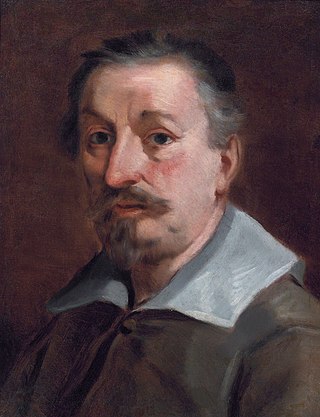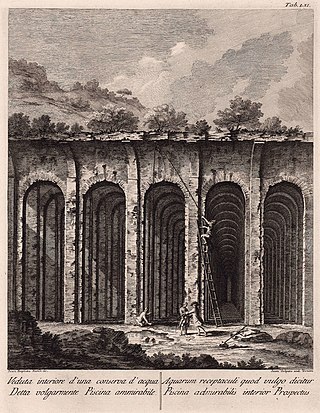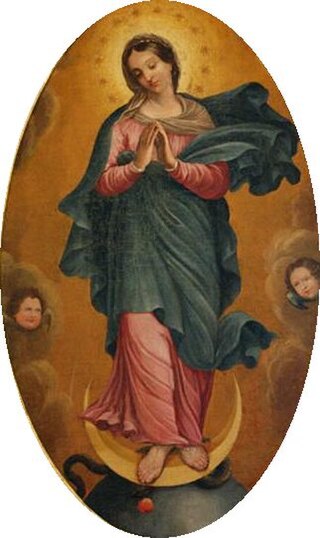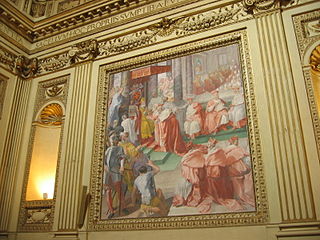Related Research Articles

Francesco Albani or Albano was an Italian Baroque painter of Albanian origin who was active in Bologna, Rome, Viterbo (1609–1610), Mantua (1621–1622) and Florence (1633).

Livio Agresti (1508–1580), also called Ritius or Ricciutello, was an Italian painter of the late Renaissance or Mannerist period, active both in his native city of Forlì and in Rome, where he died. He was one of the members of the "Forlì painting school".

Giovanni Andrea Ansaldo was an Italian painter active mainly in Genoa.

Giovanni Battista Cremonini was an Italian painter of the Renaissance period.

Giovanni Battista Merano (1632–1698) was an Italian painter of the Baroque period, mainly active in Genoa.

Giovanni Battista Natali, also known as Joan(nes) or Ioannes Baptista Natali, was an Italian painter and draughtsman of the late-Baroque period, active in his natal (?) city of Piacenza,[apparent contradiction] but also Savona, Lucca, and Naples, and finally Genoa in 1736.

Francesco Alberi was an Italian Neoclassical style painter, active in Bologna, Padua, Rimini and Rome.
Mauro Aldrovandini (1649–1680) was an Italian painter of the Baroque period. While he was most active in Bologna, and some claim he was native to the city, others claim he was born in Rovigo. He mainly painted perspective views and architectural subjects (quadratura) in private houses and for theaters.

Giacinto Campana was an Italian painter of the Baroque period.
Bartolommeo Salvestrini was an Italian painter of the Baroque period, active mostly in Florence. He was a pupil of Matteo Rosselli and Giovanni Bilivert in Florence. He painted a Martyrdom of St Ursula for church of Santa Orsula in Florence, as well as paintings for the church of Santa Teresa. He died of the plague in 1630. A drawing at the Art Institute of Chicago is attributed to the painter

Prospero Spani was an Italian sculptor of the Renaissance, active mainly in the Province of Reggio Emilia. He is variously known as Prospero Clementi or Prospero Clemente or il Clemente. Vasari claimed he was Modenese.

Jacopo Colonna or Giacomo Fantoni was an Italian sculptor active in the Renaissance.
Giacomo Coltrini was an Italian painter, active mainly in a Renaissance style in Brescia, and a military engineer for Venetian Republic. He painted frescoes for the subterranean church of San Faustino Maggiore in Brescia. He died as a military engineer in Candia. Titian's paternal uncle, Gregorio Vecelli, lived in Coltrini's house in Venice.
Francesco Comi, also known as il Muto da Verona or il Fornaretto, was an Italian painter of the Baroque Period. He was a pupil of Giovanni Gioseffo dal Sole. He was deaf and was active mainly in Verona.

Francesco Corneliani (1740–1815) was an Italian painter, mainly active in a Neoclassic style in his native Milan.

Francesco Lorenzi was an Italian painter of the late Baroque period.
Antonio Lorenzini (1655–1740) was an Italian painter and engraver of the Baroque, active in his native Bologna, as well as in Florence. He was also called the Frate Antonio. He was a pupil of Lorenzo Pasinelli. It is said that while engraving works in the church of San Francesco in Bologna, specifically the canvas by Pasinelli, where St Anthony of Padua liberates the soul of his father from Purgatory, Lorenzini was inspired to become a Franciscan.
Jacopo Loschi or Jacopo d' Ilario Loschi was an Italian painter.

Pasquale Cati was an Italian Mannerist painter active mostly in Rome.
Carlo Natali, also known as il Guardolino, was an Italian painter of the Baroque period, active in Cremona and Bologna
References
- ↑ Vite de' pittori, scultori, ed architetti genovesi, Volume 2, page 322, by Raffaele Soprani, Carlo Giuseppe Ratti, Forni Editore Bologna, 1797.
- ↑
- Boni, Filippo de' (1852). Biografia degli artisti ovvero dizionario della vita e delle opere dei pittori, degli scultori, degli intagliatori, dei tipografi e dei musici di ogni nazione che fiorirono da'tempi più remoti sino á nostri giorni. Seconda Edizione.. Venice; Googlebooks: Presso Andrea Santini e Figlio. p. 677.